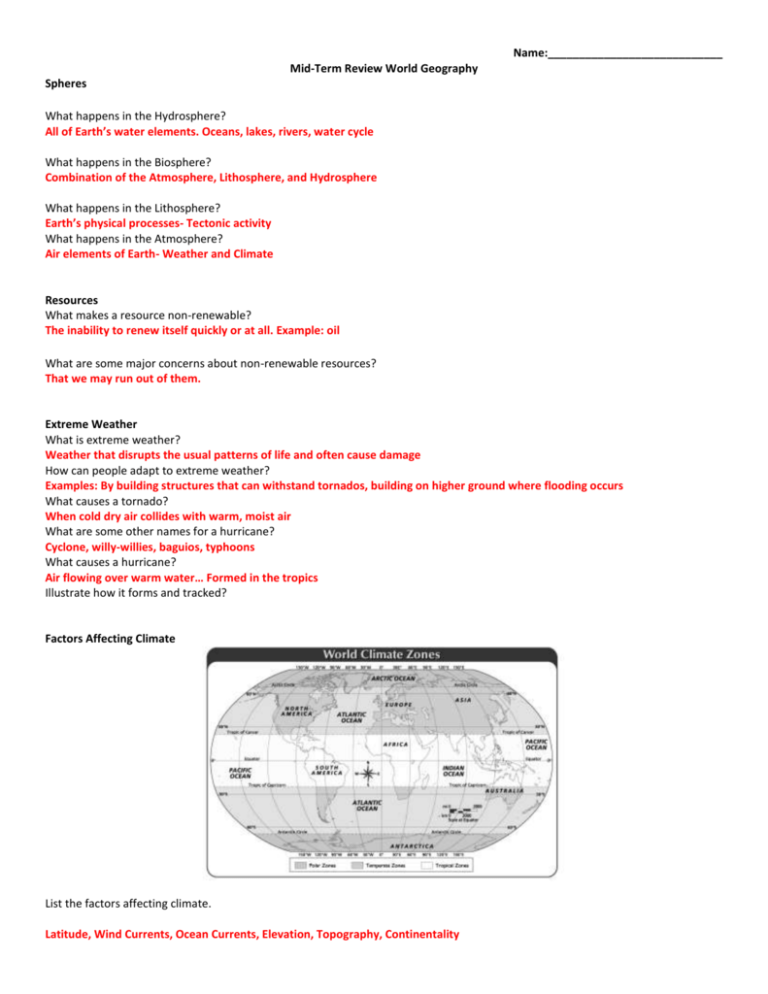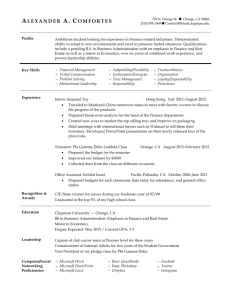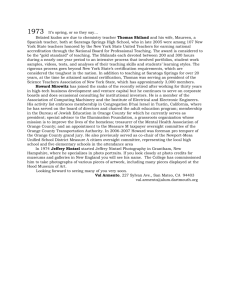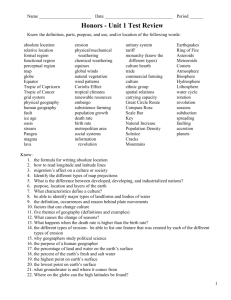Factors Affecting Climate
advertisement

Name:____________________________ Mid-Term Review World Geography Spheres What happens in the Hydrosphere? All of Earth’s water elements. Oceans, lakes, rivers, water cycle What happens in the Biosphere? Combination of the Atmosphere, Lithosphere, and Hydrosphere What happens in the Lithosphere? Earth’s physical processes- Tectonic activity What happens in the Atmosphere? Air elements of Earth- Weather and Climate Resources What makes a resource non-renewable? The inability to renew itself quickly or at all. Example: oil What are some major concerns about non-renewable resources? That we may run out of them. Extreme Weather What is extreme weather? Weather that disrupts the usual patterns of life and often cause damage How can people adapt to extreme weather? Examples: By building structures that can withstand tornados, building on higher ground where flooding occurs What causes a tornado? When cold dry air collides with warm, moist air What are some other names for a hurricane? Cyclone, willy-willies, baguios, typhoons What causes a hurricane? Air flowing over warm water… Formed in the tropics Illustrate how it forms and tracked? Factors Affecting Climate List the factors affecting climate. Latitude, Wind Currents, Ocean Currents, Elevation, Topography, Continentality Which factor is evident from the map above and plays the biggest role in climate? Latitude What do the images above tell us about climate? Proximity to water and elevation affect climate What elements of climate affect Miami? Ocean currents and Topography What elements of climate affect Denver? Elevation and topography Earth-Sun Relationship What are the elements of the earth sun relationship? Tilt of the earth and its revolution How are the northern and southern hemispheres affected? Depending on where the sun’s rays are pointing, they are in opposite seasons What is the significance of the Tropic of Cancer and Tropic of Capricorn? Sun’s rays pointing at the Tropic of Cancer means summer for the Northern Hemisphere Sun’s rays pointing at the Tropic of Capricorn mean summer for Southern Hemisphere Sun’s rays pointing at the equator means Spring or Fall, depending on the location of the Earth to the Sun What physical process forms mountains? Convergent Boundaries- Collision What physical process forms plateaus? Convergent Boundary- Collision and Erosion What physical process formed valleys? Divergent Boundary Biome Type of Climate Land Use Human Adaptation Tundra Polar, Cold Research in Antarctica Igloos, snow mobiles Taiga (Boreal Forest) subarctic climate with very large temperature range between seasons, but the long and cold winter is the dominant feature. Deciduous Forest Temperate with cool winters Deserts Hot, dry Grassland or Savanna or Steppe dry Tropical Rain Forest Hot, wet forestry Midterm Review World Geography- Units 3 and 4 Level of Development 1. What type of farming goes with primary activities, and is the prominent type in the world today?(Orange Book page 279) Subsistence; a type of farming in which most of the produce (subsistence crop) is consumed by the farmer and his family, leaving little or no surplus to be sold for income. For Questions 2-11, use Chapter 18 in the Orange Book 2. If the majority of jobs in a country are to provide services and develop technology, where who it classify on the HDI? More Developed 3. What are the best indicators to determine a countries Human Development Index (HDI) level? 4. 5. 6. 7. 8. What economic activities are done by Less Developed countries? primary What economic activities are done by Newly Industrialized countries? Primary with developing commercial agriculture (still high levels of subsistence), and the growth and expansion of SECONDARY ACTIVITES! What economic activities are done by More Developed countries? Tertiary, quaternary What is mortality rate? Death rate Give a modern example for each level and draw the shape of its population pyramid. Less Developed-Niger Newly Industrialized-Brazil More Developed-USA 9. What is GDP? Gross domestic product 10. What is GDP per capita? Gross domestic product per person 11. Country A (population 300,000,00) has an average G.D.P of $5 Billion. Country B (population 150,000,000) also has an average G.D.P. of $5 Billion. Which country has the highest G.D.P per capita? Country B, because there are less people. GDP per capita is calculated by dividing the GDP by the # of people in a country 12. Define Standard of Living( Green Book, Page 143) Level of wealth Religion Define: 13. Monotheism – Belief in one god 14. Polytheism – Belief in many gods Give detailed characteristics of each of the following religions. Make sure you include the deity/deities, number of followers, location of origins, and symbols. For questions 15-27, use page 125-130 and page 137 in the Orange World Geography Book 15. Buddhism- All life is suffering. Use Eightfold Path to achieve enlightenment and release from cycle of rebirth, or at least attain a better rebirth by gaining merit. Goal is to reach Nirvana. 16. Christianity- All have sinned and are thereby separated from God. Salvation is through faith in Jesus of Nazareth (Christ, believed to be the Messiah) and, for some, sacraments and good works. Eternal heaven or hell (or temporary purgatory). Seek to convert others. 17. Hinduism- Reincarnation until gain enlightenment through dharma and good karma. Enlightenment => moksha. 18. Islam- Five Pillars: Faith, Prayer, Alms, Pilgrimage, Fasting. Mosque services on Fridays. No alcohol or pork. Holidays related to the pilgrimage and fast of Ramadan. Seek Converts. Humans must submit to the will of God to gain Paradise after death. 19. Judaism- Obey God's commandments, live ethically. Serve God by studying the Torah and live by his teachings. God holds his people accountable for their sins and shortcomings. Focus is more on this life than the next. Beliefs in heaven or reincarnation vary, but the constant is that the soul does not perish. Believe in one god 20. Sikhism- Believe in reincarnation and combine beliefs from Islam and Hinduism. Believe in one god 21. Which religion was the first to be founded in India/South Asia? Hinduism 22. Which religion was the first founded in Middle East/Southwest Asia? Judaism 23. List the religions began in India. Hinduism, Buddhism 24. What characteristics are shared amongst the religions that began in South Asia? Belief in karma and reincarnation 25. List the religions that began in the Middle East. Judaism, Christianity, Islam 26. What characteristics are shared amongst the religions that began in Southwest Asia? Monotheism, belief in the old testament, universalizing religion (try to convert others) 27. Give two examples of how diffusion has impacted the development of a religion. Christianity is the most widespread religion due to its spread through colonization. Judaism diffused throughout Europe & to North America during the diaspora and WWII, but then movement back to SW Asia after the creation of Israel. Settlement Patterns For questions 28-35, use Ch. 10 in the Orange World Geography Book. How do each of these influence where people settle? 28. 29. 30. 31. 32. 33. Natural resourcesBodies of Water- People settle near sources of fresh water and near the coast Climate- People tend to settle in temperate climates Landforms- People settle in non-mountainous and fertile areas, such as valleys and plains Economic Activities- People move to areas where they can find jobs Urbanization- since the start of the Industrial Revolution, people moving from rural areas to cities has increased greatly 34. Transportation Routes- People often settle along transportation routes, such as coastlines, rivers, canals, railroad lines, or roads 35. Most civilizations formed around what type of physical feature? River valleys Define push factor. Give two examples. (Orange Book, Ch. 11) Push – hunger (famine), poverty, violent conflict (wars), persecution for religious or political beliefs Define pull factor. Give two examples. (Orange Book, Ch. 11) Pull – economic opportunities, freedom of religion, freedom from any type of persecution 36. What is diffusion and how does it affect culture? (Orange Book, Ch. 12) Diffusion refers to how something diffuses or spreads. The spread of new products, technology, ideas, cultural traits and diseases happens 37. What is the difference between an immigrant and an emigrant? Immigrant is moving into a country and emigrant is moving out of the country 38. What effect did the Industrial Revolution have on the world’s population? (Orange Book, page 168) It increased Mid –Term Review World Geography- Units 5 and 6 Economic Systems For questions 1-3, use Chapter 17 in the Orange Geography Book) 1. Which economic system has the most government control? Communism 2. Which economic system has the least government control? Free enterprise or market economy 3. Using the information in Chapter 17, complete the chart below. Economic Systems What to Produce? How is it Produced? Who Gets It? Traditional Set by traditions and custom According to customs Set by traditions and custom. Free Enterprise(Market, Capitalist) Interactions of producers/consumers Producers decide how to produce Consumers; prices set by supply and demand Communist Determined by government planners Determined by Supply and demand and Government regulations Government leaders decide Government decides Producers and government decide Consumers Socialist(Mixed) 4. Define Globalization. (page 457 in the Green World Geography Book) the creation of a common global culture 5. What factors have contributed to globalization? Air travel, newspapers, television, telecommunications, and the Internet. Every society quickly learns what is happening in other societies 6. Define outsourcing. (Page 411 in the Green World Geography Book) When companies hire other companies from overseas to produce parts or to provide other services 7. What are benefits of outsourcing? 8. What are negatives of outsourcing? 9. How does a company decide where to outsource services? (Why would India or Chine be a better place to outsource to than Russia or Algeria) Government For questions 10-16 , use Chapter 14 in the Orange Geography Book) 10. Which forms of government allow the most freedoms? Democracy, because the citizens get to vote on issues and elect representatives 11. Which form of government is most closely related to religion? Theocracy 12. When a dictator starts controlling all aspects of society the government becomes what? Totalitarian (dictatorship) 13. What type of monarchy is democratic? Constitutional Democracy 14. What type of monarchy is theocratic? A government ruled by aa religious leader 15. What type of democracy allows the citizens to vote on all decisions? Direct Democracy 16. Give 2 historical examples and one modern example of the following forms of government. Government Historical Examples Modern Examples Monarchy England Sweden, Norway, Great Britain, Spain Democratic Republic Athens The United States Theocracy Egypt Iran, The Vatican Totalitarian Italy, Russia, Germany North Korea Mid Term Review Unit 7 and 8 1. 2. What are the natural resources of Canada and the United States? B:120 – fossil fuels, fertile soil, and vast forests Explain the reason behind the large number of climate zones in North America. B: 123 Many different latitudes 1. List the colonial powers who settled Canada. B: 156 France and England 2. What is the primary religion of Americans? B: 143 Christianity 3. What is the primary religion of Canada? B: 161 Roman Catholic 4. What are the nicknames for the Northeast, South, and Midwest of the United States? B: 145-149 Northeast – Rustbelt South – Sun Belt Midwest – America’s Heartland or Bread Basket 5. Where do most Canadians live? B: 161 Within 100 miles of the U.S. border 6. What city/province founded in 1608 by the French is the center for French-Canadian culture? B: 167 Quebec 7. What is NAFTA, who is involved and what impact does it have on North America? B: 160 North American Free Trade Agreement. It has increased trading between The United States, Canada and Mexico. 8. What is a maquiladora and where are they located? Why do you think that is a good location? B:220 Maquiladoras are factories in Mexico that assemble imported materials into finished goods for export, mostly into the U.S. they are mostly located along the border of the United States which makes it easy to transport the goods 9. What geographic feature is the Panama Canal located on? What two bodies of water does it connect? B:222 The Panama Canal is on the Isthmus of Panama, a land bridge between N. and S. America. It connects The Pacific and Atlantic Oceans Alaska Minnesota Wyoming South California Washington Montana Iowa Missouri Kansas Dakota Vermont Maine Virginia Oregon North South North Georgia Wisconsin Nebraska Dakota Carolina Carolina Mexico Jamaica Brazil Peru Chile Guatemala Nicaragua Haiti Argentina Costa Rica French Guiana El Cuba Bolivia Venezuela Salvador Dominican Honduras Puerto Colombia Paraguay Republic Rico





